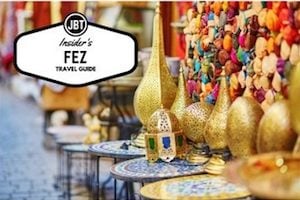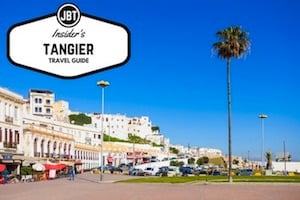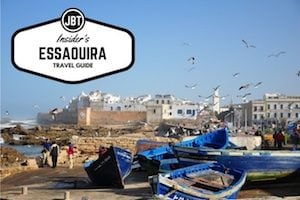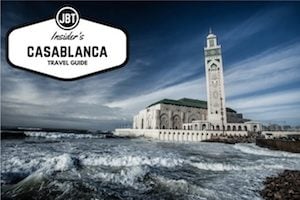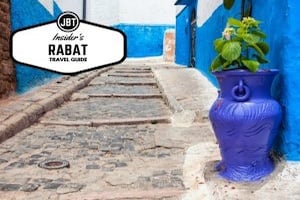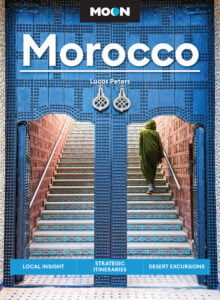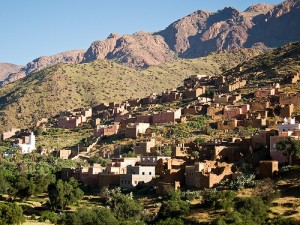 Located in southwest Morocco, the Anti-Atlas Mountains are far off the beaten path and can deliver an unspoiled experience for travelers willing to make the journey. This range derives its name from its big, better-known northern neighbors, the High Atlas Mountains, where walking and trekking in Morocco was made popular; “Anti-Atlas” means “Lesser Atlas.”
Located in southwest Morocco, the Anti-Atlas Mountains are far off the beaten path and can deliver an unspoiled experience for travelers willing to make the journey. This range derives its name from its big, better-known northern neighbors, the High Atlas Mountains, where walking and trekking in Morocco was made popular; “Anti-Atlas” means “Lesser Atlas.”
This range is hardly lesser, however, except when it comes to a tourist population. Within the mountains, outdoor enthusiasts can enjoy the landscape and glimpses of Berber village life without a crush of other visitors. The Anti-Atlas range extends all the way to Ouarzazate, where many choose to begin tours of the Sahara Desert, so many itineraries combine mountain and desert.
The Anti-Atlas Mountains stretch for more than 180 miles, ranging from the Atlantic beaches to the desert. Three cities forming a triangle—Taraoudant, Tafraoute and Tiznit—serve as jumping-off points for mountain exploration. Agadir is the nearest airport, with several domestic flights a day. Once in the region, buses connect the cities, but a private car or transportation provided by a tour operator is probably necessary to head further into the rural areas. Note that many roads in the region are unpaved—identified as pistes—so consult a reliable map with car-rental agencies to make sure you are sure of your vehicle’s capabilities.
The roads between the cities take you past crumbling kasbahs and agadirs (fortresses) dotting rocky cliffs. Dramatic rock formations and sudden bursts of wildflowers make for good photo ops. Of the mountain cities, Tafraoute is perhaps the most inviting, surrounded by peaceful and pretty walks. Nearby Ammeln Valley features prehistoric rock carvings, and the surrounding palm groves are a beautiful area for driving and hiking. Farther out, the village of Ukas has even more prehistoric cave paintings, giving a sense of how long humans have lived in these mountains. For something more modern and surreal, the “Blue Rocks” 4km from Tafraoute are massive boulders covered in 18 tons of blue paint by a Belgian artist and local firemen.
Trekking is the top activity in the region, and walks of all levels cover this region. Advanced hikers can take multi-day journeys, stopping at Berber villages along the way, while the less hardcore can keep it as simple as enjoying strolls in the foothills, taking in the scenery and clean air. Other activities popular in mountain regions have followings here—horseback riding, white-water rafting, mountain biking, birdwatching, and so on. Unlike in the High Atlas Mountains, however, there are no real ski areas. Because of the area’s remoteness, try to arrange for sporting activities before you arrive. Many operators exist to set you up with gear and direction, but they may be far-flung.
Popular treks near Tafraoute include Jebel Siroua and, perhaps the most popular, Jebel Lekst, a purple mountain. (“Jebel,” by the way, is an Arabic word used to refer to mountains and mountain ranges.)
Outside of the main cities, simple lodging (auberges) can be found in some villages, and campsites are inexpensive but lacking in modern facilities. Once out in the wilderness, supplies might be difficult to restock, but a surprising number of remote locations have decent internet coverage.
This region can have hot summers and extremely cold winters, with the weather varying widely between elevations. Technical clothes made for harsh temperatures are an absolute necessity for substantial outdoor adventuring, and even casual trekkers will want to err on the side of caution when bringing warm, comfortable clothes to layer. Dressy clothing is not needed in these rural areas, so stuff your baggage with knits and wicking fabrics. Away from the beach resorts, southwest Morocco tends to be more conservative than other parts of the country, so women will feel more comfortable being modestly dressed, with legs and shoulders covered.
Written by Brinda Gupta.
Photo by potomo.

